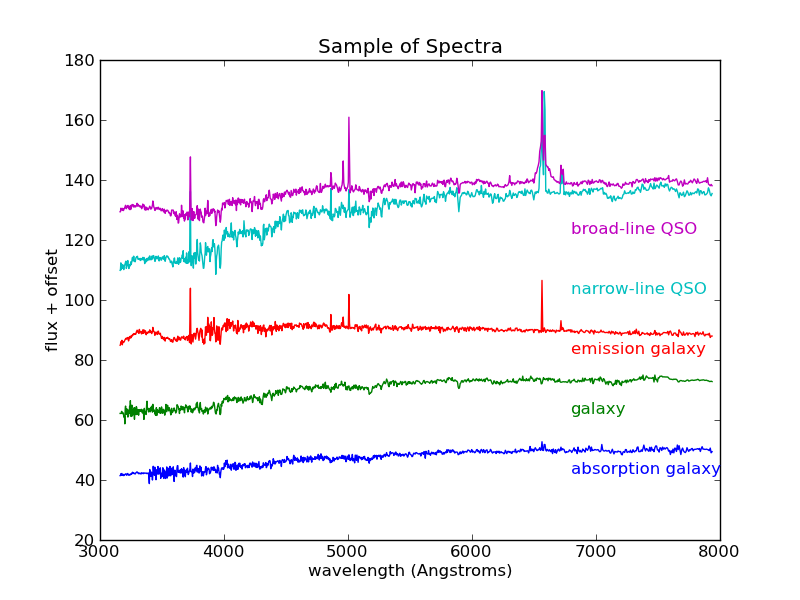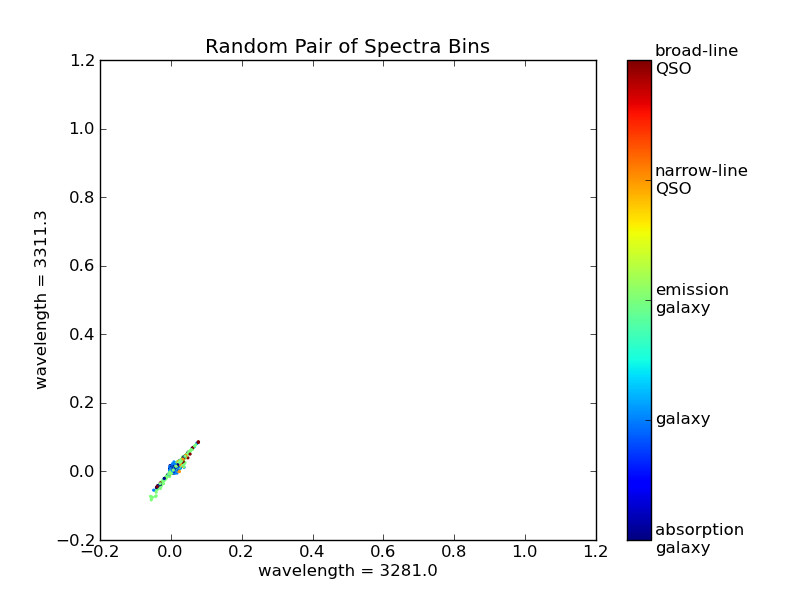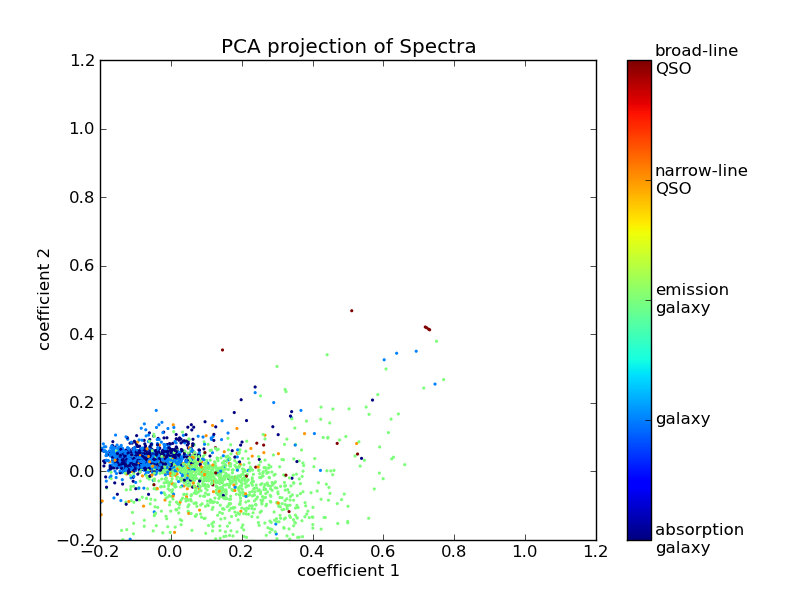2.3.6. Dimensionality Reduction of Astronomical Spectra¶
The Sloan Digital Sky Survey is a photometric and spectroscopic survey which has operated since the year 2000, and has resulted in an unprecedented astronomical database. The database contains photometric observations like those we explored in the previous sections, but also includes a large number of spectra of various objects. These spectra are essentially 4000-dimensional data vectors for each observed object, where each observation gives the flux of a particular wavelength of light.
Because of the large dimensionality of this data, visualization of the dataset becomes very challenging. This is where unsupervised dimensionality reduction methods can be useful. One of the most commonly used dimensionality reduction methods in astronomy is Principal Component Analysis (PCA). We won’t go through the mathematical details here, but PCA essentially seeks dimensions of the input data which contain the bulk of the variability present in the data. The model has this form:

Here  represents an individual spectrum.
represents an individual spectrum.  is the mean spectrum for the dataset. The remaining term encodes the
contributions of each of the eigenvectors
is the mean spectrum for the dataset. The remaining term encodes the
contributions of each of the eigenvectors  . The
eigenvectors are generally arranged so that those with the smallest
. The
eigenvectors are generally arranged so that those with the smallest  contain the most signal-to-noise, and are the most important vectors in
reconstructing the spectra. For this reason, truncating the sum at some
contain the most signal-to-noise, and are the most important vectors in
reconstructing the spectra. For this reason, truncating the sum at some
 can still result in a faithful representation of the input.
can still result in a faithful representation of the input.
For astronomical spectra, the result is that the first few coefficientts
 of each spectrum
of each spectrum  encode a good low-dimensional
representation of the spectrum. We’ll use this fact to visualize this data
in a meaningful way.
encode a good low-dimensional
representation of the spectrum. We’ll use this fact to visualize this data
in a meaningful way.
2.3.6.1. SDSS Spectral Data¶
In the directory $TUTORIAL_HOME/data/sdss_spectra/, you’ll find the script which fetches a set of spectra from the Sloan Digital Sky Survey. Each individual spectrum is at a particular redshift, and can have data missing in certain spectral regions. So that this doesn’t affect our analysis, the spectra have been de-redshifted and the gaps have been filled using the PCA-based algorithm described in [1].
Once the dataset is downloaded, it can be read-in as follows:
>>> import numpy as np
>>> data = np.load('spec4000_corrected.npz')
>>> data.files
['y', 'X', 'z', 'wavelengths']
>>> data['X'].shape
(4000, 1000)
>>> print data['labels']
['unknown' 'star' 'absorption galaxy' 'galaxy' 'emission galaxy'
'narrow-line QSO' 'broad-line QSO' 'sky' 'Hi-z QSO' 'Late-type star']
The variable X contains 4000 spectra, each with 1000 attributes. In addition, the file includes a classification code y, and redshift z for each spectrum, and an array wavelengths which can aid in plotting spectra. Let’s plot a few of these to see what they look like, making sure to choose a representative of each of the interesting classes:
>>> import pylab as pl
>>> pl.ion()
>>> X = data['X']
>>> y = data['y']
>>> wavelengths = data['wavelengths']
>>> labels = data['labels']
>>>
>>> for i_class in (2, 3, 4, 5, 6):
... i = np.where(y == i_class)[0][0]
... l = pl.plot(wavelengths, X[i] + 20 * i_class)
... c = l[0].get_color()
... pl.text(6800, 2 + 20 * i_class, labels[i_class, color=c)
...
>>> pl.subplots_adjust(hspace=0)
>>> pl.xlabel('wavelength (Angstroms)')
>>> pl.ylabel('flux + offset')
>>> pl.title('Sample of Spectra')

A sample from among the most interesting classes of object. These objects are classified based on their emission and absorption characteristics.
There are 4000 spectra in this file, each with 1000 attributes. Visualizing a dataset of this size can be very difficult. We could plot all 4000 spectra as we did above, but the plot would quickly become too complicated. As a first step, it might be helpful to ask what the average spectrum looks like. To do this, we’ll plot the mean, but first we’ll normalize the spectra. Because the spectra represent galaxies at distances that range over several hundreds of light-years, their total flux varies greatly. Thus it will help if we normalize the spectra. For this we’ll use the scikit-learn preprocessing module. We’ll then plot both the mean and standard deviation to give us an idea of the data we’re working with:
>>> from sklearn import preprocessing
>>> X = preprocessing.normalize(X)
>>> mu = X.mean(0)
>>> std = X.std(0)
>>> pl.plot(wavelengths, mu, color='black')
>>> pl.fill_between(wavelengths, mu - std, mu + std, color='#CCCCCC')
>>> pl.xlim(wavelengths[0], wavelengths[-1])
>>> pl.ylim(0, 0.06)
>>> pl.xlabel('wavelength (Angstroms)')
>>> pl.ylabel('scaled flux')
>>> pl.title('Mean Spectrum')
The result is shown in the following figure:

The mean and standard deviation of the normalized spectra. Some of the
largest variation is found at wavelengths at which Hydrogen absorbs and
emits photons (Hydrogen is by far the most abundant atom in the universe).
For example, the line at 6563 is known as Hydrogen- , and is
often seen in emission (spiking up) in quasars and other active galaxies.
, and is
often seen in emission (spiking up) in quasars and other active galaxies.
The interesting part of the data is in the gray shaded regions: how do spectra vary from the mean, and how can this variation tell us about their physical properties? One option to visualize this would be to scatter-plot random pairs of observations from each spectrum. We’ll first create a formatter object to make the colorbar labels pretty:
>>> from matplotlib.ticker import FuncFormatter
>>> format = FuncFormatter(lambda i, *args: labels[i].replace(' ', '\n'))
Now we plot the data:
>>> pl.figure()
>>> np.random.seed(25255) # this seed is chosen to emphasize correlation
>>> i1, i2 = np.random.randint(1000, size=2)
>>> pl.scatter(X[:, i1], X[:, i2], c=y, s=4, lw=0, vmin=2, vmax=6, cmap=pl.cm.jet)
>>> pl.colorbar(ticks = range(2, 7), format=format)
>>> pl.xlabel('wavelength = %.1f' % wavelengths[i1])
>>> pl.ylabel('wavelength = %.1f' % wavelengths[i2])
>>> pl.title('Random Pair of Spectra Bins')
There is a clear correlation between these two measurements. That is, if you know the value of one, then you could quite accurately predict the value of the other. This shows us that some of the spectral bins do not add much information, and can be ignored. One could imagine proceeding by trial and error, plotting pairs of points and seeing which ones provide the most interesting information, but this would be very tedious. Instead, we can use an automated technique for dimensionality reduction, one well-known example of which is Principal Component Analysis.
2.3.6.2. Principal Component Analysis¶
Principal Component Analysis (PCA) is an often-used tool in astronomy
and other data-intensive sciences. In a
sense, it automates the trial-and-error process discussed in the previous
section, and finds
the most interesting linear combinations of attributes, so that
high-dimensional data can be visualized in a 2D or 3D plot. Scikit-learn
has methods to compute PCA and several variants. Classic PCA
(sklearn.decomposition.PCA) is based on
an eigenvalue decomposition of the data covariance, so that for  points, the computational cost grows as
points, the computational cost grows as ![\mathcal{O}[N^3]](../../_images/math/c0f39b210b8d93d5710751f1350edf622633d5c0.png) . This means
that for large datasets like the current one, the fit can be very slow. You
can try it as follows, but the computation may take up to several minutes
for this dataset:
. This means
that for large datasets like the current one, the fit can be very slow. You
can try it as follows, but the computation may take up to several minutes
for this dataset:
>>> from sklearn.decomposition import PCA
>>> pca = PCA(n_components=4)
>>> X_projected = pca.fit_transform(X) # warning: this takes a long time!
Fortunately, scikit-learn has an alternative method that is much faster. The speed comes at a price: it is based on random projections, so the results are not as robust as the normal method. But for tasks such as ours where we are seeking only a few of a large number of eigenvectors, it performs fairly well. To keep our results consistent between runs, we’ll explicitly set the random seed for the fit. You should repeat this with several different random seeds to convince yourself that the results are consistent. Also, because these spectra have a wide range in:
>>> from sklearn.decomposition import RandomizedPCA
>>> rpca = RandomizedPCA(n_components=4, random_state=0)
>>> X_proj = rpca.fit_transform(X)
>>> X_proj.shape
(4000, 4)
X_proj is now a reduced-dimension representation of X, where the lower-index columns are the most important dimensions. We can visualize the spectra now using the first two columns:
>>> pl.figure()
>>> pl.scatter(X_proj[:, 0], X_proj[:, 1], c=y, s=4, lw=0, vmin=2, vmax=6, cmap=pl.cm.jet)
>>> pl.colorbar(ticks = range(2, 7), format=format)
>>> pl.xlabel('coefficient 1')
>>> pl.ylabel('coefficient 2')
>>> pl.title('PCA projection of Spectra')
We now have a two-dimensional visualization, but what does this tell us?
Looking at the PCA model in the equation above, we see that each component
is associated with an eigenvector, and this plot is showing  and
and  where
where

Visualizing the eigenvectors  can give insight into what
these components mean:
can give insight into what
these components mean:
>>> pl.figure()
>>> l = pl.plot(wavelengths, rpca.mean_ - 0.15)
>>> c = l[0].get_color()
>>> pl.text(7000, -0.16, "mean" % i, color=c)
>>> for i in range(4):
... l = pl.plot(wavelengths, rpca.components_[i] + 0.15 * i)
... c = l[0].get_color()
... pl.text(7000, -0.01 + 0.15 * i, "component %i" % (i + 1), color=c)
>>> pl.ylim(-0.2, 0.6)
>>> pl.xlabel('wavelength (Angstroms)')
>>> pl.ylabel('scaled flux + offset')
>>> pl.title('Mean Spectrum and Eigen-spectra')
We see that the first eigenspectrum (component 1) tells us about the relative difference in flux between low wavelengths and high wavelengths - that is, the color of the spectrum. Component 2 tells us a lot about the emission and absorption characteristics in the various lines, and also in the so-called “4000 angstrom break” due to Hydrogen absorption. Detailed analysis of these components and eigenspectra can lead to much physical insight about the galaxies in the fit (See, for example [1]).
Nevertheless, there are some weaknesses here. First of all, PCA does not do a good job of separating out galaxies with different emission characteristics. We’d hope for a projection which reflects the fact that narrow spectral features are very important in the classification. PCA does not do this. In a later exercise, we’ll explore some alternative nonlinear dimensionality reduction techniques which will address this deficiency of PCA.



